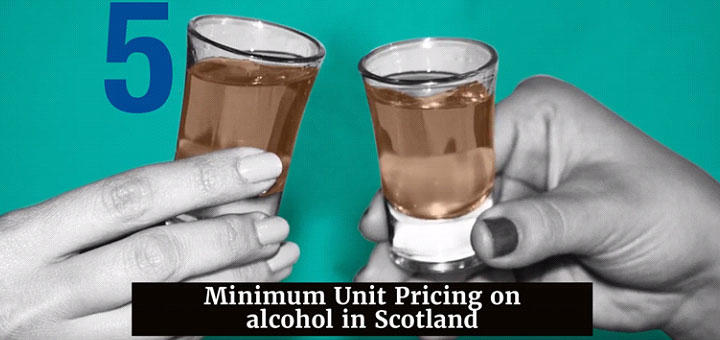Public health has historically had a significant positive impact, improving the health and life course of the nation. As far back as 1848, the Public Health Act was instrumental in introducing sanitation, refuse systems and medical officers into local areas. In the last two centuries, we have seen major advances in medicine, hygiene, technology, planning, infrastructure, food, and many other areas that influence the public’s health. This has resulted in the average life expectancy in the UK for a female born between 2016 and 2018 of 82.9 years.
But what has public health achieved more recently? Although we are generally much healthier than people were 150 years ago, there is still more to be done to tackle the modern health issues facing us. We compiled a long list of public health interventions and achievements that took place during the first twenty years of the 21st century in the UK. RSPH members voted, resulting in the shortlist which was ranked by senior public health professionals. These are the results.
1. The smoking ban
Probably the only entry on this list that almost any member of the public could tell you something about – and for good reason. The 2007 ban on smoking in enclosed public spaces was the kind of landmark legislation that just doesn’t come around every year, marking a huge shift in the public mind-set. For most, the sight and smell of smoke-filled pubs, clubs, restaurants and workplaces are now a distant memory; for those too young to remember, it is probably hard to imagine that things were once this way at all. This speaks to the fact that, alongside the obvious health benefits of reduced smoking rates (both active and passive) since 2007, the indoor ban has been crucial in the de-normalisation of smoking in public.
Perhaps most significantly, the smoking ban has helped shift the balance from the rights of smokers to poison others to the rights of others not to be poisoned. This has been reflected in the level of public support for the law, which has risen to 83% over the twelve years since its introduction. The ban is even backed by the majority of smokers nowadays – 52% of whom support it, with only 25% opposing. Polling by ASH earlier this year showed that popular support for Government to do more to limit smoking has increased leaps and bounds since the smoking ban, increasing from 29% in 2009, to 39% in 2017, and reaching 46% in 2019.
This shift has had wider consequences, arguably giving more oxygen to ideas that might once have seemed infeasible: smoking was banned in private cars with under 18s in 2015, plain cigarette packaging was introduced in 2016, and we are seeing more and more local and voluntary initiatives for smoke-free public spaces outdoors. Just this year, the Government announced its ambition to end smoking by 2030, with a mandatory levy on industry as one option they will consider for funding this goal.
There is still much work to be done. Smoking remains the leading cause of preventable death and the picture for health inequalities is worrying – more must be done to bring down stubbornly high rates among routine and manual workers, and those with mental health conditions, for example. Nevertheless, the UK has made tremendous strides in bringing down rates, with the smoking ban underpinning and paving the way for the comprehensive programme of tobacco control that we see today.
2. The soft drinks industry levy (‘sugar levy’)
The Soft Drinks Industry Levy (SDIL) was introduced as part of the government’s childhood obesity plan in April 2018. Manufacturers have to pay a charge for drinks containing over 8g of sugar. The levy has so far encouraged product reformulation, with the Public Health Minister reporting at the time of its launch that nearly half of the soft drinks market had been proactive in reducing sugar in their products to avoid charges. It also signalled a shift towards greater recognition of the role to be played by the food and drink industry in enabling healthier choices.
3. Marmot review into health inequalities and understanding of the social determinants of health
The Marmot Review of 2010 was a Government-commissioned report looking at the landscape of health inequalities in England, and what could be done about them. The review made a strongly evidenced case that health inequalities have social determinants, and that health and wellbeing were just as important measures for society as economic growth. While not being as well-known among the public as other entries to the ranking, the Marmot Review marked a real agenda shift for those working in public health. It reframed the narrative around determinants of health, and established a political imperative to tackle inequalities from a health perspective.

4. Sure Start children’s centres (2000-2010)
Sure Start children's centres were designed to deliver a place in every community that would provide integrated care and services for young children and their families, with a particular focus on closing the achievement gap for children from disadvantaged backgrounds.
5. Minimum Unit Pricing on alcohol in Scotland
Minimum unit pricing (MUP) in Scotland for all alcoholic drinks was introduced in May 2018, following a string of court proceedings in which the Scotch Whisky Association fought against the legislation tooth and nail. The policy – which sets a minimum price of 50p under which a unit of alcohol cannot be sold – works by targeting the affordability of the cheapest alcohol products on the market, which is where the most harm sits.
Over the first year since implementation, MUP appears to have successfully reduced the amount of alcohol purchased by households in Scotland, with these reductions coming specifically within households that buy the most. Scottish ministers expect the changes to save almost 400 lives within the first five years of the new pricing rules. As a high profile example of a fiscal intervention that is effective in improving health outcomes, the policy has gained widespread support from many leading medical, public health, and police organisations. Wales, Northern Ireland and the Republic of Ireland are all at various stages of following Scotland’s lead, and looking forward to the 2020s, it would be a great shame if England were to get left behind.

6. HPV vaccination for boys and girls
The introduction of a human papillomavirus (HPV) vaccine for girls aged 12-13 since 2008 has been a great success, with research in Scotland finding a dramatic reduction in cervical pre-cancer among vaccinated women. HPV also causes other cancers in both men and women. While most men are protected under a girls-only vaccination programme, there are still many who are not, including men who have sex with men. To cover these gaps in herd immunity, the vaccine is now also offered to boys. Public Health England estimates that this universal programme will prevent 64,138 HPV-related cervical cancers and 49,649 other HPV-related cancers by 2058.
7. Congestion charge and ultra-low emission zone
The congestion charge was introduced in London in 2003, with the primary aim of cutting the number of private vehicles entering London during the day. It enforced a mandatory fee for vehicles driving within the Congestion Charge Zone (CCZ), and in 2019 this was taken a step further with the introduction of the ultra-low emission zone (ULEZ), coming into force across the same area as the CCZ. Both measures were brought in to tackle traffic rates by discouraging driving in this highly polluted area. Overall they have been successful interventions, with congestion reduced by 30% following the CCZ, and the ULEZ leading to substantial emissions reductions in NO2, CO2, and other pollutants.
Transport is a great example of a wider determinant of health. Though these two measures were primarily established for reasons only indirectly related to health outcomes, they have potentially huge ramifications in terms of road injuries, air quality, physical activity and mental health. As a result they have had a significant influence on the level of public debate around the relationship between transport, pollution, and our wellbeing.

8. Decriminalisation of abortion in Northern Ireland
Abortion in Northern Ireland was decriminalised in October 2019, allowing women and healthcare professionals to terminate a pregnancy without risk of prosecution. Up until this point, termination was only allowed if a woman’s life was at risk or if there was serious risk of damage to her physical or mental health.
9. Wellbeing of Future Generations Act in Wales
In 2015 this act was brought in, requiring public bodies in Wales to think about the long-term impact of their decisions, to work better with people, communities and each other, and to prevent persistent problems such as poverty, health inequalities and climate change. Another example of the importance of legislation as a tool for improving public health, the Act is a momentous first step towards embedding the concept of intergenerational equity in everything we do, and changing health outcomes for the better for generations to come.
10. Tobacco advertising bans
There is a clear and extensive evidence base on the relationship between tobacco advertising and consumption, with children and young people being most susceptible to this influence. Historically, no one has been more aware of this link than the industry that has so successfully exploited it, driving forward the global tobacco epidemic by finding ever more inventive ways to market death in a stick.
Thankfully, in the 21st Century the UK has seen the steady but sure implementation of a comprehensive and wide-ranging set of advertising bans – starting with the Tobacco Advertising and Promotion Act of 2002. Beginning with a ban on print media and billboard advertising (2002), advertising and promotion of tobacco were subsequently banned at Formula One events through sponsorship (in 2002), at vending machines (in 2009), in point-of-sale displays in shops (in 2009), and finally through packaging (in 2016 – via the introduction of mandatory standardised ‘plain packs’).

11. Traffic light labelling on pre-packaged food
The traffic light labelling system was introduced by the government in 2013 as a clearer way to display nutritional information. The label includes information on calories, fat, saturated fat, salt and sugar. The system is currently voluntary, but there have been calls to make it mandatory due to the benefits for consumers.
12. Transferral of Public Health into Local Authorities
Responsibility for commissioning public health services was moved from the NHS to local authorities and the newly established Public Health England in 2013. At the time, the government ring-fenced a portion of public health funding for local authorities.
Despite being hamstrung by persistent cuts to the public health budget through the second decade of the century, councils have delivered improvements across 80% of the public health outcomes framework, and the rationale for local government leadership in public health remains sound. The strongest determinants of our health and wellbeing are the circumstances in which we live, and whether that means education, environment, housing or employment, local authorities remain well placed to influence these.
13. Scores on the Doors food hygiene ratings
Scores on the Doors started in 2005 as Food Hygiene Information collected by Local Authorities. The Food Standards Agency standardised the scheme, and in 2012 the Food Hygiene Rating Scheme was rolled out across every food business in the UK. Compliance across the UK has improved by 50% due to the initiative.

14. The Time to Change Campaign, run by Mind and Rethink Mental Illness
Time to Change is a campaign run by charities Mind and Rethink Mental Illness. It aims to improve public attitudes and behaviour towards people with mental health problems and reduce the amount of discrimination that people with mental health problems report in their personal relationships, social lives and at work.
15. Fixed-odds betting terminals stake limit reduced to £2
In 2018, the UK government reduced the maximum stake on Fixed Odds Betting Terminals (FOBTs) from £100 to £2. FOBTs have been described as the ‘crack cocaine’ of gambling, with their capacity to be played rapidly and repeatedly representing a serious addiction issue.

16. Introduction of childhood flu vaccine
The UK began primary-school-based pilots of child flu vaccination in 2013. They were a success, seeing falls in flu cases and influenza-related hospital visits for both children and adults in the community. Since 2019-20, flu vaccines are now rolled out for all primary school children in the UK every year.
17. Reduction in homelessness between 2003 and 2009
The 2002 Rough Sleepers Unit target to reduce the number of people sleeping rough by two-thirds was met a year earlier than planned. The recognition that rough sleeping was a product of a wide range of problems led to a new focus on prevention and recovery. Following this, the Supporting People programme was launched in 2003 as a £1.8 billion ring-fenced grant to local authorities. Supporting People paid for accommodation-based services and interventions aimed at helping vulnerable people, including people who had been sleeping rough, to live independently.
The number of homeless households dropped sharply between 2003 and 2009 from 135,000 to just over 40,000. However, that number has since been rising steadily, up 50% between 2010 and 2017. Though this is still 56% below 2003 levels, homelessness remains a deeply ingrained and growing problem with strong ties to health inequalities – and it cannot be addressed without a sustained and well-funded commitment from the Government.
18. Junk food advertising ban during kids TV and across London transport network
In April 2007, communications regulator Ofcom banned adverts for foods high in fat, salt and sugar during television programmes aimed at children under the age of 16, in an effort to curb childhood obesity. In February 2019, a similar ban across the Transport for London network came into force.

19. Drug safety testing at festivals and nightclubs
Drug safety testing is a harm reduction intervention that, especially in the second decade of the century, has been occurring in a growing number of countries worldwide – as well as notably in the UK, through extensive piloting at a number of festivals and nightclubs since 2013. It involves providing facilities where users can have their substances anonymously tested, after which they receive information on the strength and contents of the sample, along with tailored advice on how to minimise the harms from taking them. Drug safety testing pilots at two UK festivals in 2016 saw almost one in five users dispose of their drugs once aware of the content. When implemented at the Secret Garden Party festival in 2016, there was a 95% reduction in drug-related hospital admissions from the previous year.
The UK’s spiralling drug-related deaths call for a far-reaching re-think of drugs policy, and safety testing can only be one part of the solution. However, it has been a totemic intervention within a growing movement towards a more compassionate approach to drugs policy – an approach that puts ‘harm reduction’ centre stage in pursuing a framework for reform that sees drug use first and foremost as a matter of public health, and not of criminal justice.
20. Cancer screening improvements
Bowel screening programmes began in England in 2006, Scotland in 2007, Wales in 2008 and in Northern Ireland in 2010. Patients aged 50 are offered a one-off bowel scope screening test. Research in 2017 suggested that bowel cancer incidence was 35% lower and mortality 40% lower among those screened. Breast cancer screening coverage also increased from 2002 to 2011.
Honourable mentions
- Teenage Pregnancy Strategy for England
- The English health inequalities strategy
- Pre-exposure prophylaxis (PrEP) medication for preventing HIV
- Introduction of Naloxone as an antidote for opioid overdoses
- National Policy Planning Framework
These successes demonstrate the potential public health measures can have on improving health for all. We hope that the next twenty years of the 21st century continue to drive forward positive health outcomes, so that we all have the chance to live longer, healthier lives
